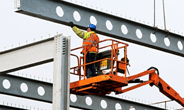Analysis

August 12, 2021
AGC: Producer Prices Increasing at Alarming Rate
Written by David Schollaert
The steep rise in prices for construction materials and services continued in July, as contractors grapple with supply challenges, reported the Associated General Contractors of America in its latest analysis of government data.
AGC officials have urged the Biden administration to immediately end tariffs and quotas on steel, aluminum, lumber and other essential construction items to help stave off inflationary pressure in the construction industry.
“July was the sixth-straight month of double-digit price increases for construction inputs,” said Ken Simonson, AGC’s chief economist. “In addition, lead times to produce or deliver many items keep lengthening. Many reports since the government collected this price data in mid-July show the trend will continue, at a minimum into autumn and likely beyond, unless tariffs and quotas are removed.”
The producer price index for new nonresidential construction – a measure of what contractors say they would charge to erect five types of nonresidential buildings – rose 4.4% over the past 12 months. That was a small fraction of the 25.6% increase in the prices that producers and service providers such as distributors and transportation firms charged for construction inputs, Simonson noted.
There were double-digit percentage increases in the selling prices of materials used in every type of construction. The producer price index for steel mill products more than doubled from July 2020 to last month, leaping 108.6%.
The index for lumber and plywood jumped 56.8% despite a large drop in mill prices from May to July. The copper and brass mill shapes index rose 49.0% and the index for aluminum mill shapes increased 33.2%. Plastic construction products rose 26.7%, while gypsum products such as wallboard climbed 21.6%. The index for insulation materials rose 11.8%, while the prepared asphalt and tar roofing and siding products index rose 10.9%.
In addition to increases in materials costs, transportation and fuel costs also spiked. The index for truck transportation of freight jumped 13.8%.
Association officials urged the president to remove tariffs on key construction materials, including steel and aluminum. They noted that some countries have opted for quotas on steel and aluminum in place of tariffs, making supplies even tighter. These government limitations on key materials, if left in place, would undermine some of the benefits of the new infrastructure measure that passed in the Senate, they said.
“These tariffs and quotas are artificially inflating the cost of many key materials and doing more damage to the economy than help,” said Stephen Sandherr, AGC’s CEO. “Leaving these measures in place will undermine the broader benefits of the bipartisan new infrastructure measure the House should be passing.”







